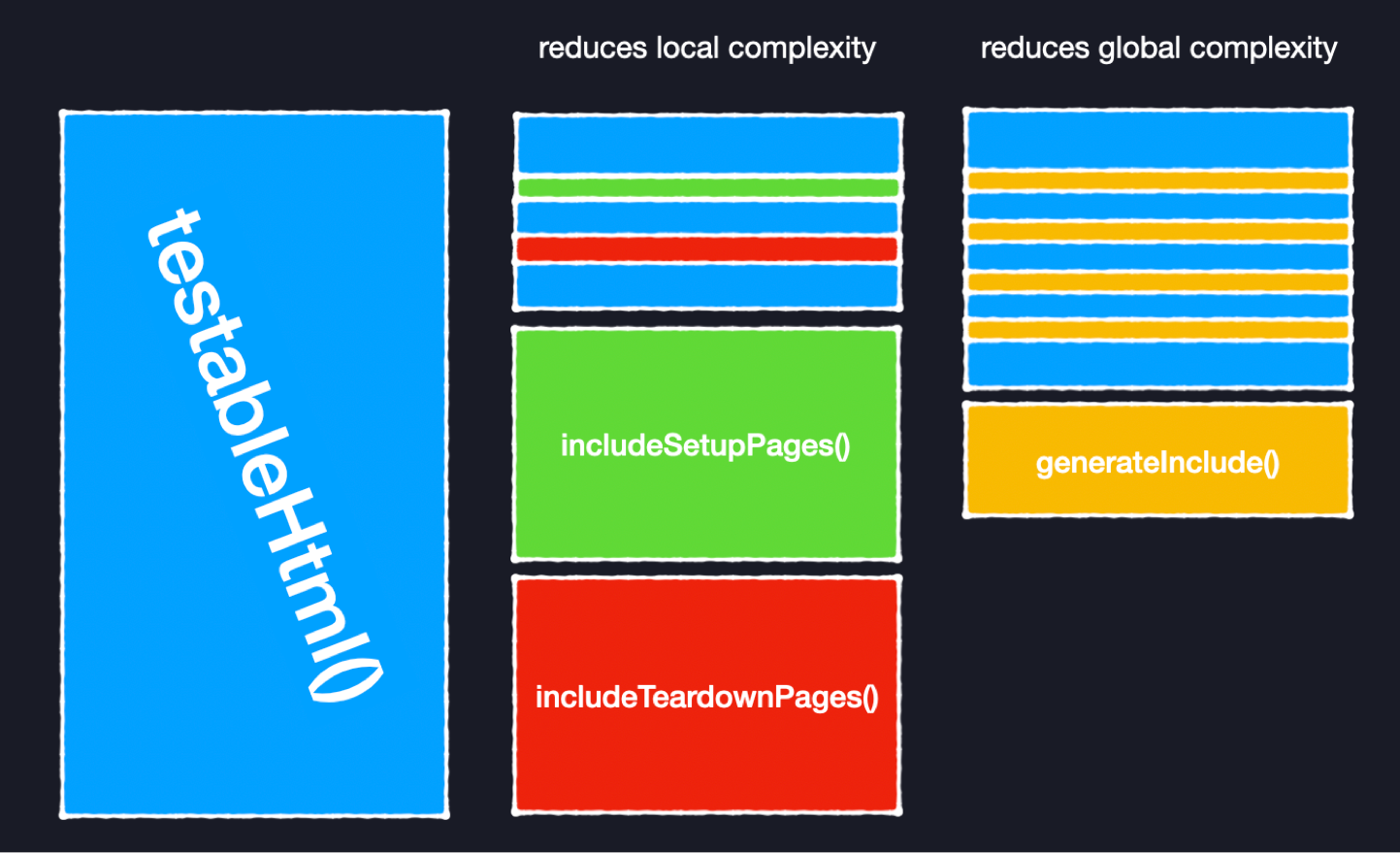Chapter 3: Functions
The chapter begins by showcasing an example of "bad" code:
public static String testableHtml(PageData pageData, boolean includeSuiteSetup) throws Exception {
WikiPage wikiPage = pageData.getWikiPage();
StringBuffer buffer = new StringBuffer();
if (pageData.hasAttribute("Test")) {
if (includeSuiteSetup) {
WikiPage suiteSetup =
PageCrawlerImpl.getInheritedPage(
SuiteResponder.SUITE_SETUP_NAME, wikiPage
);
if (suiteSetup != null) {
WikiPagePath pagePath = suiteSetup.getPageCrawler().getFullPath(suiteSetup);
String pagePathName = PathParser.render(pagePath);
buffer.append("!include -setup .")
.append(pagePathName)
.append("\n");
}
}
WikiPage setup =
PageCrawlerImpl.getInheritedPage("SetUp", wikiPage);
if (setup != null) {
WikiPagePath setupPath = wikiPage.getPageCrawler().getFullPath(setup);
String setupPathName = PathParser.render(setupPath);
buffer.append("!include -setup .")
.append(setupPathName)
.append("\n");
}
}
buffer.append(pageData.getContent());
if (pageData.hasAttribute("Test")) {
WikiPage teardown = PageCrawlerImpl.getInheritedPage("TearDown", wikiPage);
if (teardown != null) {
WikiPagePath tearDownPath = wikiPage.getPageCrawler().getFullPath(teardown);
String tearDownPathName = PathParser.render(tearDownPath);
buffer.append("\n")
.append("!include -teardown .")
.append(tearDownPathName)
.append("\n");
}
if (includeSuiteSetup) {
WikiPage suiteTeardown =
PageCrawlerImpl.getInheritedPage(
SuiteResponder.SUITE_TEARDOWN_NAME,
wikiPage
);
if (suiteTeardown != null) {
WikiPagePath pagePath = suiteTeardown.getPageCrawler().getFullPath (suiteTeardown);
String pagePathName = PathParser.render(pagePath);
buffer.append("!include -teardown .")
.append(pagePathName)
.append("\n");
}
}
}
pageData.setContent(buffer.toString());
return pageData.getHtml();
}
And the proposes refactoring:
public static String renderPageWithSetupsAndTeardowns(PageData pageData, boolean isSuite) throws Exception {
boolean isTestPage = pageData.hasAttribute("Test");
if (isTestPage) {
WikiPage testPage = pageData.getWikiPage();
StringBuffer newPageContent = new StringBuffer();
includeSetupPages(testPage, newPageContent, isSuite);
newPageContent.append(pageData.getContent());
includeTeardownPages(testPage, newPageContent, isSuite);
pageData.setContent(newPageContent.toString());
}
return pageData.getHtml();
}
The original version operates on multiple levels of detalization and juggles multiple domains at the same time:
- API for fitness objects: working with
WikiPage,PageData,PageCrawleretc - Java string manipulation: Using StringBuffer to optimize string concatenation (it should be StringBuilder).
- Business logic: Handling suites, tests, setups, and teardowns in a specific order.
When everything presented at the same level it indeed looks very noisy and hard to follow. (the book touches this in "One Level of Abstraction per Function")
Martin's trick here is simple: show that smaller code is easier to understand than larger code.
This works because he doesn't show the implementation of includeSetupPages and includeTeardownPages
But... extracting non-reusable methods doesn’t actually reduce complexity or code size, at best it just improves navigation.
What objectively reduces code size is removing repetitions (the fancy term - Anti-Unification): the original code as bad as it is can be significantly improved by a small change - extract code duplication into helper method:
public static String testableHtml(PageData pageData, boolean includeSuiteSetup) {
if (pageData.hasAttribute("Test")) { // not a test data page
return pageData.getHtml();
}
WikiPage wikiPage = pageData.getWikiPage();
List<String> buffer = new ArrayList<>();
if (includeSuiteSetup) {
buffer.add(generateInclude(wikiPage, "Suite SetUp", "-setup"));
}
buffer.add(generateInclude(wikiPage, "SetUp", "-setup"));
buffer.append(pageData.getContent());
buffer.add(generateInclude(wikiPage, "TearDown", "-teardown"));
if (includeSuiteSetup) {
buffer.add(generateInclude(wikiPage, "Suite TearDown", "-teardown"))
}
pageData.setContent(buffer.stream().filter(String::nonEmpty).join("\n"));
return pageData.getHtml();
}
private static String generateInclude(WikiPage wikiPage, String path, String command) {
WikiPage inheritedPage = PageCrawlerImpl.getInheritedPage(path, wikiPage);
if (inheritedPage != null) {
WikiPagePath pagePath = inheritedPage.getPageCrawler().getFullPath(inheritedPage);
String pagePathName = PathParser.render(pagePath);
return "!include " + command + " ." + pagePathName;
} else {
return "";
}
}
Is it noisier than Martin's version? Yes. But most people would answer "YES" to the posed question "Do you understand the function after three minutes of study?" And it's a small change to the original mess.

The real problem
Despite these improvements, we're missing the critical issue: both versions modify the PageData object as a side effect.
Both testableHtml and renderPageWithSetupsAndTeardowns overwrite PageData's content to generate HTML.
This hidden behavior, not the code structure, is the real problem.